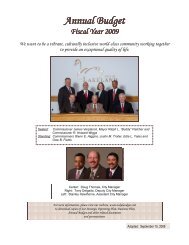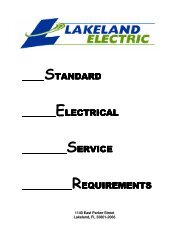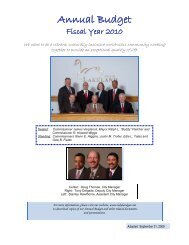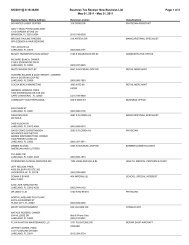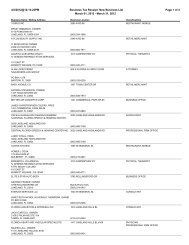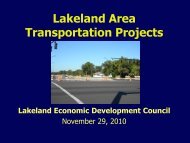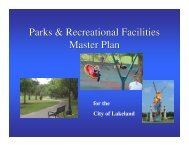CONSOLIDATED PLAN & STRATEGY 5-YEAR ... - City of Lakeland
CONSOLIDATED PLAN & STRATEGY 5-YEAR ... - City of Lakeland
CONSOLIDATED PLAN & STRATEGY 5-YEAR ... - City of Lakeland
You also want an ePaper? Increase the reach of your titles
YUMPU automatically turns print PDFs into web optimized ePapers that Google loves.
Accessory Dwelling units<br />
The <strong>City</strong> amended its Land Development regulations to allow accessory dwelling<br />
units (ADU) in residential zoning districts. ADUs may provide affordable units for<br />
retirees, single persons, couples and students while attending college or preparing to<br />
become independent.<br />
HOMELESS<br />
Homeless Needs (91.205 (b) and 91.215 (c))<br />
*Please also refer to the Homeless Needs Table in the Needs.xls workbook<br />
Homeless Needs— The jurisdiction must provide a concise summary <strong>of</strong> the nature<br />
and extent <strong>of</strong> homelessness in the jurisdiction, (including rural homelessness and<br />
chronic homelessness where applicable), addressing separately the need for facilities<br />
and services for homeless persons and homeless families with children, both<br />
sheltered and unsheltered, and homeless subpopulations, in accordance with Table<br />
1A. The summary must include the characteristics and needs <strong>of</strong> low income<br />
individuals and children, (especially extremely low income) who are currently housed<br />
but are at imminent risk <strong>of</strong> either residing in shelters or becoming unsheltered. In<br />
addition, to the extent information is available, the plan must include a description <strong>of</strong><br />
the nature and extent <strong>of</strong> homelessness by racial and ethnic group. A quantitative<br />
analysis is not required. If a jurisdiction provides estimates <strong>of</strong> the at-risk<br />
population(s), it should also include a description <strong>of</strong> the operational definition <strong>of</strong> the<br />
at-risk group and the methodology used to generate the estimates.<br />
3-5 Year Strategic Plan Homeless Needs response:<br />
The McKinney-Vento Homeless Assistance Act <strong>of</strong> 1986 and HUD homeless assistance<br />
programs are governed by a definition <strong>of</strong> homelessness found in United States Code<br />
Title 42, Chapter 119, Subchapter 11302 that reads: (a) In general, for purposes <strong>of</strong><br />
this chapter, the term “homeless” or “homeless individual or homeless person”<br />
includes— (1) an individual who lacks a fixed, regular, and adequate nighttime<br />
residence; and (2) an individual who has a primary nighttime residence that is— (a)<br />
a supervised publicly or privately operated shelter designed to provide temporary<br />
living accommodations (including welfare hotels, congregate shelters, and<br />
transitional housing for the mentally ill); (b) an institution that provides a temporary<br />
residence for individuals intended to be institutionalized; or (c) a public or private<br />
place not designed for, or ordinarily used as, a regular sleeping accommodation for<br />
human beings. HUD defines a chronically homeless person as “an unaccompanied<br />
homeless individual with a disabling condition who has either been continuously<br />
homeless for a year or more OR has had at least four (4) episodes <strong>of</strong> homelessness<br />
in the past three (3) years.” To be considered chronically homeless a person must<br />
have been on the streets or in an emergency shelter (i.e., not in transitional<br />
housing) or in a Safe Haven as defined by HUD. Chronically homeless persons are a<br />
subgroup <strong>of</strong> homeless persons that tend to be the most visible.<br />
3-5 Year Strategic Plan 47




